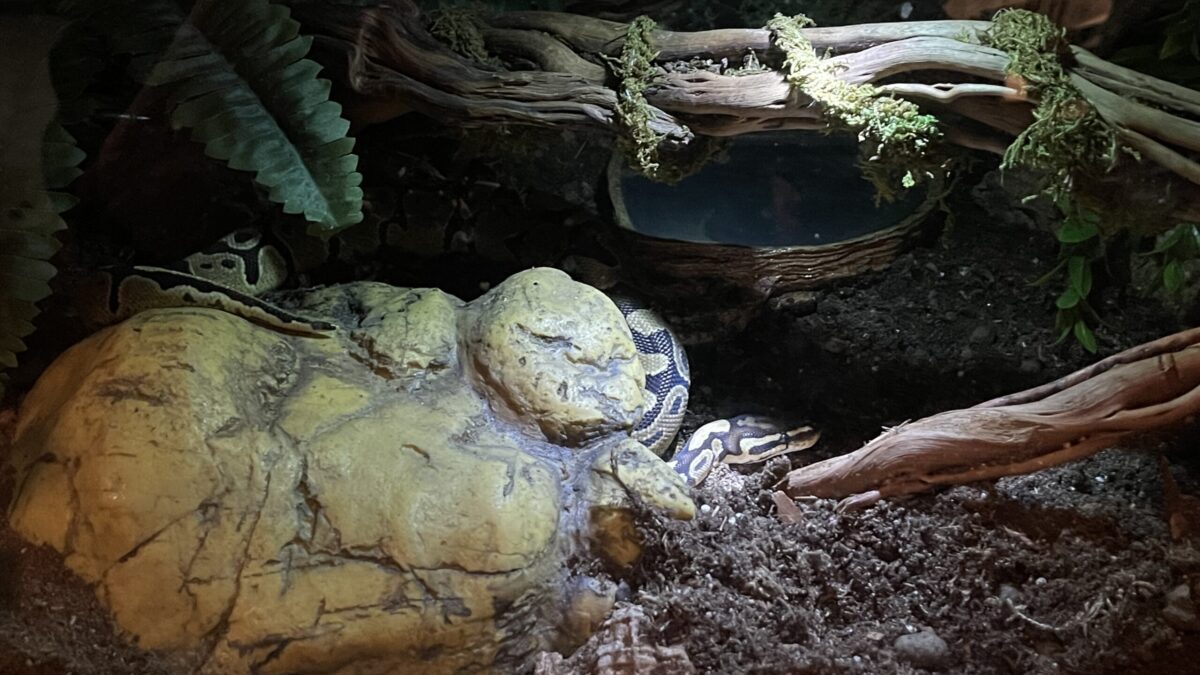
Ty-Lee, a Success Story
May 4, 2023
Breed Specific: The Determined Miniature Pinscher
June 10, 2023By Tayler, CVT
I’m Tayler and I am a vet tech at PPVC. If you had asked me 18-24 months ago if I would ever work with, let alone own a snake, I would have told you “Heck NO!”
Spoiler alert: Lots of amazing snake pictures follow!
However, after working alongside Dr. Fowler, I gained an intertest in owning a ball python of my own. I researched about them on Reptifiles and found all the care sheets provided for ball pythons. I learned what different morphs are out there and what special requirements each might have. Then, I decided I would LOVE to have one. My husband was ecstatic, as he had always wanted one as well.
in August of 2022, I made the leap (or slither?) and acquired Athena at the Reptile Expo in Denver. Dr. Fowler has taken a huge interest in my care of her, and she is now a thriving 9-month-old Vanilla Morph Ball Python.


Between Reptifiles, The Bio Dude, and general Google searches, I did hours of reading on recommended substrates for ball pythons. I decided a bio-active enclosure is what I would like to house my future snake due to its ease of maintenance. I took recommendations from The Bio Dude about the environment of the enclosure, and researched the cost of the soil, the isopods, and the springtails, to the correct temperature (86-90°F warm and 86-90°F cool), humidity (60-80%), etc., I’m sure I spent days doing my research. Thanks to the encouragement of Dr. Fowler, we decided we would move forward with getting our snake and getting her happy and situated.
We got extremely lucky in finding a bio-active enclosure already put together, but if that is not in your cards, The Bio Dude, or Custom Reptile Habitats have kits you can buy. They also have recommendations on the number of things that should be included based on the size of your enclosure.
Once we had everything we needed, I was so excited to get her home set up! We placed her home in a safe spot while I wet everything in the enclosure, then set up the hygrometer (temperature/humidity gauge) and water dish, as well as started the heat lamp to get the enclosure to the recommended temperatures (which is controlled by the thermostat).
The enclosure we found was a 75-gallon fish tank. Two out of four sides are “blacked out” or covered with decorative window cling, (three out of four sides is recommended). We lined it with some cardboard to help hold in her heat. The top of the mesh is covered in HVAC tape, or aluminum tape, but ONLY THE OUTER MESH, not inner mesh! Due to the mischievous nature of ball pythons, it is recommended not to put anything sticky in the enclosure as it can be very harmful if it gets stuck to the snake! The HVAC tape on top of the mesh has saved my humidity and heat so much. There is a small square cut out of the tape so that the heat lamp can do its work. I placed aluminum foil over the open areas for more insulation to keep the heat more consistent in the enclosure.
Keep in mind that the enclosure’s length and depth need to be about the expected length of a full-grown snake. Male ball pythons can grow to around 4 feet long and Females can be almost 6 feet long at full growth. Athena and I are currently awaiting the arrival of a custom-made upgraded tank from Custom Reptile Habitats. Athena will move from her 75-gallon tank to a 120-gallon tank measuring 4’x2’x2’.

We finally placed Athena into her new home. I misted her enclosure every day to every other day to help build her humidity. Once the humidity reached recommended levels, I diminished how often I misted.
Keep in mind that you need to rewet the soil regularly. In our conditions, Athena’s soil needs rewetting once every 7-10 days. In order to do this, I pull everything out, rinse it off, and literally saturate the substrate. Once saturated I mix it for 2-3 min to ensure everything is damp, then reset it in her enclosure.
When I reset the soil, sometimes I mix up which plants go where and which branches go where. (My plants/branches are fake because I cannot keep plants alive, but live plants are best!). Athena always has a hot-side hide, and a cool-side hide. The water dish is placed on the very edge of the warm side where the heat lamp can still help the water to evaporate and help with humidity, but not where the water could become too hot for those times when she would like to soak in her dish.
When we brought Athena home, we were very novice in our care. I would say it has taken me three to six months to feel more comfortable in the care of Athena and her enclosure. Dr. Fowler is incredibly happy with my set up for her and says that her growth is the proof anyone needs. When we got Athena in August 2022, she was about 12-14 inches long, and 128g. Nine months later she is close to 30 inches long and almost 500g!!!

2022 necklace


growing like a weed!
Athena’s care now involves rewetting the substrate every 7-10 days, checking her water and humidity levels, cleaning out her water dish and rinsing of her plants, and feeding as directed based on her weight. Currently she eats 10-15% of her body weight every 10-14 days. She eats like a champ and has never refused a feeding (yet). During her enrichment time outside of her enclosure, which she loves, I let her explore around my person, on/in a hex ball (dog toy), or in a pop-up dog kennel that I place out in the sun (on warmer days) with some of her tank pieces (branches, water dish, and hide).

I hope this helps some of you who are on the fence about owning a snake in the future or gives you a look into the level of care and attention needed for these sweet reptiles! If you have any questions, Dr. Fowler is a wonderful resource and I would be happy to share more of my journey with Athena as needed.






